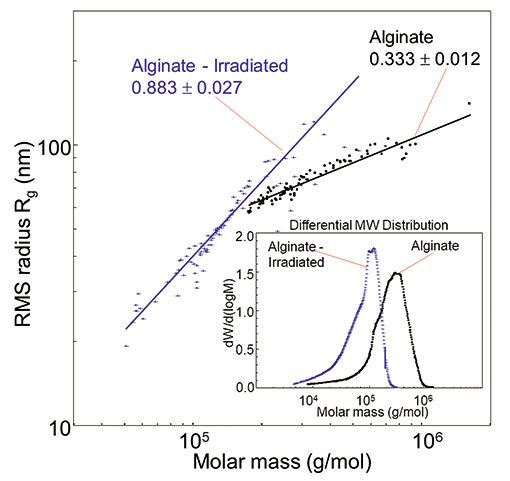Irradiation-Induced Degradation of Sodium Alginate
The Application Notebook
Sodium alginate is a food thickening agent that may be irradiated for sterilization. Changes in biopolymer molar mass and conformation are analyzed by SEC-MALS.
Sodium alginates are widely used as a food additive or as a sterile wound dressing. The molecular weight and conformation properties of this polysaccharide contribute directly to their end-use performance. When used as a thickening agent, the higher the molecular weight, the better the gel properties.
There has been considerable interest in recent years in the development of suitable test methods to characterize foods that have been irradiated to prolong shelf life. This note describes work undertaken on a grade of sodium alginate used as a food thickening agent, employing a DAWN multiangle light scattering (MALS) detector and Optilab differential refractometer (both from Wyatt Technology, Santa Barbara, CA) in conjunction with SEC, to determine the effect of gamma irradiation on the biopolymer.
Experimental Conditions
A HEMA Bio Linear column (PSS, Mainz, Germany) was installed in a Waters 600 chromatograph (Waters Corp., Milford, MA). The flow rate was 1.0 mL/min of pure HPLC-grade water. The alginate's specific refractive index increment, dn/dc, was measured off-line in an Optilab which operates at the same wavelength as the DAWN. Absolute molar mass (MW) and size (rms radius, Rg) at each elution volume were determined by analysis of the light scattering and refractive index signals in ASTRA software (Wyatt Technology), which converted the data to differential MW distributions and conformation plots.
Results
The differential molecular weight distributions presented as the inset of Figure 1 clearly indicate the degradation in molecular weight (MW) that occurs after irradiation, with peak MW dropping by up to 70%. Of much greater interest, however, was the change in molecular conformation, shown in the main figure. Multiangle light scattering shows these changes by determining both the size and MW, independently, at each elution volume and plotting log(Rg) as a function of log(MW). The resulting slopes reveal whether the molecule is a sphere (slope of about 0.33), random coil (slope of 0.5-0.6), or rod (slope of 1.0).

Figure 1: Conformation plot (RMS radius versus Mw) of sodium alginate, before and after irradiation. Inset: Differential molecular weight plots before and after irradiation.
The conformation plot suggests that the natural, un-irradiated alginate has a compact, sphere-like structure. In the irradiated sample, by contrast, the slope of about 0.88 indicates that the molecules apparently have "opened" to a nearly rod-like structure.
The radiation dose given to the sodium alginate caused the molecule to change from a fairly dense, sphere-like, cross-linked structure to a rod-like conformation. This suggests that the cross-linking bonds are damaged or destroyed by the irradiation, causing the molecule to extend and/or expand, and hence modifying its performance as a food thickener or wound dressing.
Conclusions
SEC-MALS provides detailed information on the molecular weight and conformational changes induced in sodium alginate and similar polysaccharides by irradiation. The molecular-level changes may then be correlated to macroscopic changes in end-use performance for a deeper understanding of this phenomenon and the viability of such treatment.

Wyatt Technology Corporation
6330 Hollister Avenue, Santa Barbara, CA 93117
tel. +1 (805) 681-9009, fax +1 (805) 681-0123,
e-mail: info@wyatt.com
Website: www.wyatt.com

New Study Reviews Chromatography Methods for Flavonoid Analysis
April 21st 2025Flavonoids are widely used metabolites that carry out various functions in different industries, such as food and cosmetics. Detecting, separating, and quantifying them in fruit species can be a complicated process.
Analytical Challenges in Measuring Migration from Food Contact Materials
November 2nd 2015Food contact materials contain low molecular weight additives and processing aids which can migrate into foods leading to trace levels of contamination. Food safety is ensured through regulations, comprising compositional controls and migration limits, which present a significant analytical challenge to the food industry to ensure compliance and demonstrate due diligence. Of the various analytical approaches, LC-MS/MS has proved to be an essential tool in monitoring migration of target compounds into foods, and more sophisticated approaches such as LC-high resolution MS (Orbitrap) are being increasingly used for untargeted analysis to monitor non-intentionally added substances. This podcast will provide an overview to this area, illustrated with various applications showing current approaches being employed.

.png&w=3840&q=75)

.png&w=3840&q=75)



.png&w=3840&q=75)



.png&w=3840&q=75)














